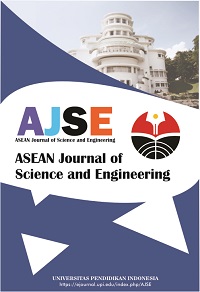Techno-economic Analysis on the Production of Zinc Sulfide Nanoparticles by Microwave Irradiation Method
Abstract
Keywords
Full Text:
PDFReferences
Abraham, S. D., David, S. T., Bennie, R. B., Joel, C., and Kumar, D. S. (2016). Eco-friendly and green synthesis of BiVO4 nanoparticle using microwave irradiation as photocatalyst for the degradation of alizarin red S. Journal of Molecular Structure, 1-26.
Astuty, A. N., Salsabila, A. R. M., Roslina, D., Aulia, F. N., Shafira, N., Rahayu, N., and Nandiyanto, A. B. D. (2020). Economic evaluation of carbon nanoparticles production through non-thermal plasma method. Journal Matter Environment Science, 11, 1966-1975.
Benedetto, F. D., Bernardini, G. P., Costagliola, P., Plant, D., and Vaughan, D. J. (2005). Compositional zoning in sphalerite crystals. American Mineralogist, 1384-1392.
Fang, X., Zhai, T., Gautam, U. K., Li, L., Wu, L., Bando, Y., and Golberg, D. (2011). ZnS nanostructure: from synthesis to applications. Progress in Material, 175-287.
Hedenquist, J. W., Arribas, A., and Gonzalez-Urien, E. (2000). Epithermal gold deposits. Review in Economyc Geology, 13(2), 45-47.
Jiang, C., Zhang, W., Zou, G., Yu, W., and Qian, Y. (2007). Hydrothermal synthesis and characterization of ZnS microspheres and hollow nanospheres. Materials Chemistry and Physics, 10, 1-4.
Kryshtab, T., Khomchenko, V. S., Andraca-Adame, J. A., Savin, A. K., Kryvko, A., Juarez, G., and Pena-Sierra, R. (2009). Luminescence and structure of ZnO-ZnS thin films prepared by oxidation of ZnS films in air and water vapor. Journal Luminescence, 1677-1681.
Lin, Y., Lin, Y., Meng, Y., and Wang, Y. (2014). CdS quantum dots sensitized ZnO spheres via ZnS overlayer to improve efficiency for quantum dots sensitized solar cells. Ceramics International, 40(6), 8157-8163.
Ma, X., Song, J., and Yu, Z. (2011). The light emission properties of ZnS: Mn nanoparticles. Thin Solid Films, 5043-5045.
Madi, A. (2020). Karakteristik mineralisasi pada endapan hidrotermal prospek Beringin Halmahera Mineral, Halmahera Utara, Provinsi Maluku Utara. Jurnal GEOMining, 1(1), 38-48.
Maji, S. K., Dutta, A. K., Srivastava, D. N., Paul, P., Mondal, A., and Adhikary, B. (2011). Effective photocatalytic degradation of organic pollutants by ZnS nanocrystals synthesized via thermal decomposition of single-source precursor. Polyhedron, 2493-2498.
Mehta, S. K., and Umar, A. (2011). highly sensitive hydrazine chemical sensor based on mono-dispersed rapidly synthesized PEF-coated ZnS nanoparticles. Talanta, 2411-2416.
Nandiyanto, A. B. D., Ragadhita, R., and Istadi, R. (2020). Techno-economic analysis for the production of silica particles from agricultural wastes. Moroccan Journal of Chemistry, 801-818.
Prabowo, F. H. E. (2019). Price determination of chicken porridge msmes in facing raw material cost fluctuation. Management Review, 3(1), 273-275.
Rashad, M. M., Rayan, D. A., and El-Barawy, K. (2010). Hydrothermal synthesis and magnetic properties of Mn doped ZnS nanoparticles. Journal of Physics: Conference Series 200, 7, 1-5.
Roy, M. D., Herzing, A. A., Lacerda, S. H. P., and Becker, M. L. (2008). Emission-tunable microwave synthesis of highly luminescent water soluble CdSe/ZnS quantum dots. Chemical Communications, 2106-2108.
Sabaghi, V., Davar, F., and Fereshteh, Z. (2018). ZnS nanoparticles prepared via simple reflux and hydrothermal method: optical and photocatalytic properties. Ceramics International, 1-34.
Sabah, A., Javed, S., and Nazir, M. (2015). Green one step microwave assisted synthesis of ZnS nanoparticles. The Nucleus, 52(4), 165-168.
Saenger, D. U., Jung, G., and Mennig, M. (1998). Optical and structural properties of doped ZnS nanoparticles produced by the sol-gel method. Journal of Sol-Gel Science and Technology, 635-639.
Salavati-Niasari, M., Davar, F., and Mazaheri, M. (2009). Synthesis and characterization of ZnS nanoclusters via hydrothermal processing from [bis(salicylidene)zinc(II)]. Journal of Alloys and Compounds, 470(1-2), 502-506.
Salavati-Niasari, M. Ranjbar, M., and Ghanbari, D. (2012). A Rapid Microwave Route for The Synthesis of ZnS nanoparticles. Journal of Nanostructures, 231-235.
Savalia, R. V., Patel, A. P., Trivedi, P. T., Gohel, H. R., and Khetani, D. B. (2013). Rapid and economic synthesis of schiff base of salicylaldehyde by microwave irradiation. Research Journal of Chemical Sciences, 97-99.
Schaefer, S. C., and Gokeen, N. A. (1982). Electrochemical determination of the thermodynamic properties of sphalerite, ZnS (beta). High Temp Sci, 15, 225-237.
Soltani, N., Saion, E., Hussein, M. Z., Bahrami, A., Naghavi, K., and Yunus, R. B. (2012). Microwave irradiation effects on hydrothermal and polyol synthesis of ZnS nanoparticles. Chalcogenide Letters, 9(6), 265-274.
Xue, L., Shen, C., Zheng, M., Lu, H., Li, N., Ji, G., Pan, L., and Cao, J. (2011). Hydrothermal synthesis of graphene–ZnS quantum dot nanocomposites. Materials Letters, 65, 198-200.
Yang, Y. J. (2015). One-pot synthesis of reduced graphene oxide zinc sulfide nanocomposite at room temperature for simultaneous determination of ascorbic acid, dopamine, and uric acid. Sensors and Actuators B: Chemical, 750-759.
Yeh, C. Y., Lu, Z. W., Froyen, S., and Zunger, A. (1992). A zinc blende wurtzite polytypism in semiconductors. Physical Review B, 46(16), 10086-10097.
Zhu, J., Zhou, M., Xu, Z., and Liao, X. (2000). Preparation of CdS and ZnS nanoparticles using microwave irradiation. Material Letters, 47, 25-29.
DOI: https://doi.org/10.17509/ajse.v2i2.37791
Refbacks
- There are currently no refbacks.
Copyright (c) 2021 Universitas Pendidikan Indonesia

This work is licensed under a Creative Commons Attribution-ShareAlike 4.0 International License.












